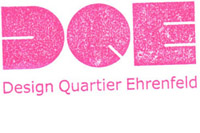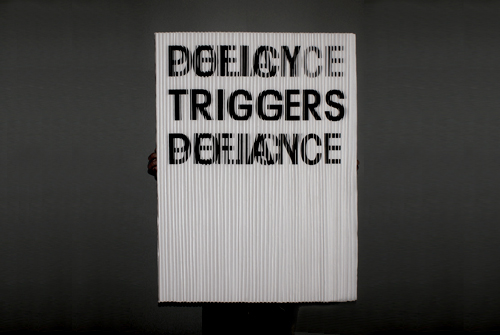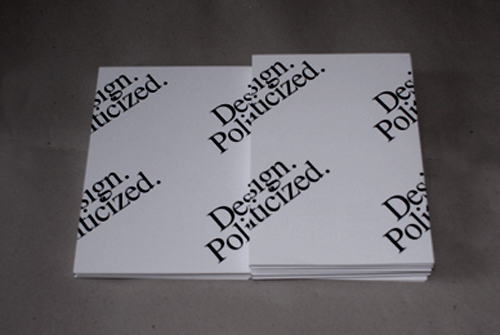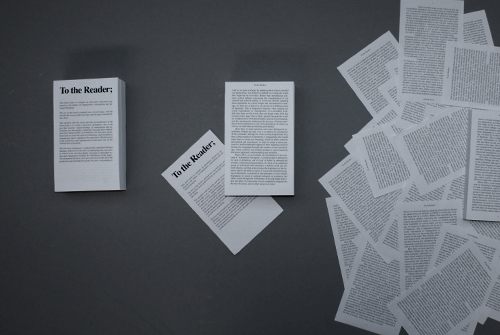
|
|
DESIGN. POLITICIZED

Die Ausstellung "Design. Politicized" zeigt gemeinsame Grafikdesign-Arbeiten von Florian Conradi und Michelle Christensen. Nach Tel Aviv, Jerusalem und Amsterdam ist dies die erste Kölner Ausstellung des in Ehrenfeld lebenden und arbeitenden deutsch-dänischen Künstlerduos. Michelle Christensen und Florian Conradi experimentieren damit, politische Themen der unterschiedlichsten Lebenswelten in Design zu übertragen, wie die Immigrationsdebatte in Westeuropa, den Krieg in Afghanistan und im Irak, Kindersoldaten in Uganda, oder die Israelische Armee. Die sozio- politische Komplexität unserer Gesellschaft ist das zentrale Thema, das sich wie ein roter Faden durch das Werk der beiden Künstler zieht. Die Analyse komplexer Situationen und deren Sichtbarmachung durch den gestalterischen Eingriff des Grafikdesigners, also die soziale und visuelle Auseinandersetzung, kommen in einer sehr einprägsamen Ästhetik zum Ausdruck: "Thinking, doing, re-assessing, re-doing, re-considering, and then finally attempting to bring into being something that grasps the multiple realities encountered in the process of creating, and then aiming to situate the result within a transdisciplinary contextualized setting, in which the intimation and implication of design can be questioned and renegotiated as a socially responsive and critically aware act."
Das experimentelle Setting ist selbst Teil der Arbeit wie in der Fahnen- Arbeit "Deconstructing the UN-Blue": Die politische Komplexität, die sich hinter der scheinbar verbindenden Institution der Vereinten Nationen verbirgt, wird mithilfe statistischer Methodologie analysiert und mit drei 1 x 1,5 m großen Flaggen, dem „research book“ und einer Audioinstallation visualisiert. Die einheitlich blaue Flagge der UN, die die Einheit und Gleichheit zwischen den Nationen symbolisiert, wird durch eine aufgrund der statistischen Daten graduierten Übereinanderlegung der Nationalflaggen der 192 Nationen dekonstruiert.
Der experimentelle Charakter der Ausstellung findet sich auch in der Ausstellungsarchitektur wieder, die dem Besucher einen Weg durch die Exponate vorgibt und ihn animiert, sich mit den einzelnen Arbeiten auseinanderzusetzen. Die Grafik-Installation "Lack of Careful Attention / Afghanista" die die fatale Ähnlichkeit von Clusterbomben und Hilfs- paketen thematisiert, die beide von Flugzeugen der US-Armee über Afghanistan abgeworfen wurden, spielt mit dem Moment der haptischen Einbeziehung des Betrachters: Um die Nachricht zu verstehen, muss der Besucher die Bücher, die auf dem Boden liegen, öffnen und erfährt somit das Potential der multiplen Realität scheinbar gleicher Objekte.
Neben den grafischen Arbeiten wird auch der 2008 fertig gestellte Dokumentarfilm "This is your problem, and that is my problem … you know … but it is not the problem of the audience" gezeigt. Dem Film liegt eine 3-monatige Reise in die nördlichen Regionen Ugandas zugrunde. Die Filmemacher haben mit ehemaligen weiblichen Kindersoldaten und Institutionen gesprochen, umfangsreiches Filmmaterial produziert und fanden sich dann dem Problem gegenüber, wie das Material für ein westliches Publikum montiert werden könnte, ohne dadurch die komplexe Situation zu simplifizieren. Es sollte nicht nur das Leiden und die Opferbereitschaft der Kindersoldaten, weder noch nur deren Stärke und dessen Empowerment dargestellt werden. Die hitzige Auseinandersetzung der Filmemacher, wie die Komplexität gestalterisch umgesetzt werden kann, ist die Basis des 23-minütigen Dokumentarfilms. Der Film wurde u.a. an der Universität Amsterdam, bei Amnesty International und in der Galerie Nieuwe Vide Art Space präsentiert.

DESIGN. POLITICIZED / REFLECTION

So, why did we accept the offer to do this exhibition?
I think that it was a combination of several factors. But mainly, the idea of placing work which is graphic design based within an interior design fair seemed like an interesting challenge. I think that this merging and crossing different design fields, perhaps even queering the field in general, this reflects the fluctuating position of a contemporary ‘designer.
And I think that for me, it was especially intriguing to place our social/political ‘graphic design’ work within an interior design fair. This seemed to be at least as surprising to the audience as it was to us. So, first of all there was the factor that it was mainly ‘graphic’, secondly there was the factor that it was political, and thirdly there was the factor that the work was not customer based or mass produced, all of which added to the discussion of what can in fact be characterized as design and to what extent it should be placed within isolated traditional fields. Actually, quite some of the ‘design audience’ at the exhibition seemed to think that it was art, and not at all design.
Well, that is not particularly surprising. ‘Graphic’ or ‘Communications’ design does not have a strong history of being exhibited in the first place. And naturally, when you place an object in an artistic looking exhibition space within a cultural context, then it somehow gets associated to the meaning of art by a broader audience. But anyway, when is design art, and when is design design? And when is art art, and when is art design? Should there be a definition, or should there not be one at all?
I think that there is something particularly interesting about design, and for me there is in fact a difference. The lack of clarity might occur because the answer lies neither in the product or the media, nor in the presentation of this, but rather in the thinking process behind it. During the exhibition, we presented projects that completely transgressed one media or functionality, but every work was created from the perspective of ‘graphic design thinking’. This does not mean that your work cannot be understood and placed in both an art and a design context, but perhaps it is important for you as the individual ‘creator’ to place yourself, in order to be able to challenge the borders of your field? I mean, in many ways it might even seem appropriate to move into the art field with our work, but we choose not to, exactly because we are interested in challenging the perception of ‘the designer’ and what that designer can and should be ‘producing’. Hence the name of the exhibition, ‘Design Politicized’. This title contains two meanings: it reflects the political content of the design works, but it also refers to politicizing design in the sense of questioning the role that it plays and the potentials that it holds.
Yes, and that remains the question: Can design be used to start debates in society…to instigate a challenge to, or change within, discourses and mentalities? Can design be a critical act? Can it function as more than a tool to supply a form to commercial messages or to create pretty consumable things? Maybe the context of this exhibition was a personal success to me from the beginning, because it was an experiment and an aim to explore how design could be shown from this perspective within a design context.

It was definitely an experiment to take the work and through it out there, unaware of what to expect of this particular audience, or what they in turn might expect from you. But I have to say, in that context; sometimes being a politically driven graphic designer is like jumping into a pool with no water. Or perhaps a pool with an unknown amount of water. There seems to be water in the sense of an understanding or an audience or a market, but then again, that is just an abstract notion, so you are not really sure if it exists or what might happen.
Sometimes I wonder though, if I really care so much about the opinion of the ‘broader audience’…or…well…I think I am always focusing on communicating directly to the individual who sees and actually makes an effort to understand the work. I try to bring complexity down to a simplicity which contains multiple perspectives. So maybe it is enough for me to have the opportunity for my work to be ‘exposed’. Then I do believe that the people who want to understand it…they can.
Its funny, some people said that the work was very complex. But I don’t think that it is. You just have to look at it for ten seconds. Time and complexity is not the same…
A designer once raised the issue that the horror of making your work public is that, due to interpretation, your message will always be misunderstood. But I don’t think that our work attempts to communicate one message or opinion to people. I think that it rather attempts to show multiple perspectives within one context, in order to encourage the receiver to actively place themselves within a debate or a mentality. The work is meant to be internalized and interpreted. So there is no misunderstanding, just an understanding. And anyway, without the process of interpretation and perception, there is no work; the work doesn’t really exist at all.
Yes, but that is design. I mean; perhaps I am not an artist, exactly because I give too much a shit. It is my main objective that the message is understandable and graspable to people. The work is not just emotional or abstract; it attempts to be communicative, although it perhaps experiments with the hybrid intersections of art and design, theory and design, and transdisciplinary ‘design’ in general. And what was great about the context of this exhibition was that the space was hybrid too, it was not a predefined space. It was not an art-space or a gallery. It was an exhibition space - for design - and this was even the first exhibition in the space. So it was really not pre-defined.
This was actually particularly great. These spaces, the undefined spaces, they contain the opportunity for interpretation and surprise. And this is design, and this is especially political graphic design. It is such a young field – and that is what makes it different from art. There is room for insecurity and surprise. There is an attempt, but a struggle, of a definition; and that is what makes up the great potential of the field. Insecurity. Young, undefined revolutions and naive, yet critical, attempts. Anything can happen. It is beautiful. And when the undefined space hosts the undefined attempts, then ambiguous things can happen.
And it is using this element of people’s insecurity and surprise – the moment when they don’t know how to judge a situation…a work…a message…that is when you can affect people and transform something. That was the potential of this situation.
Yes, and it is this insecurity that creates mental mobility. And mental mobility is what makes us not stagnate. Designers as instigators, exhibition spaces as host bodies, and the audience as receivers.
|
|
ÖFFNUNGSZEITEN
18.–20.1. + 22.–24.1.2010, 12–21 Uhr
21.1.2010, 12–24 Uhr
DQE-Halle
Heliosstr. 35–37
50825 Köln

LINK
www.conradichristensen.eu |